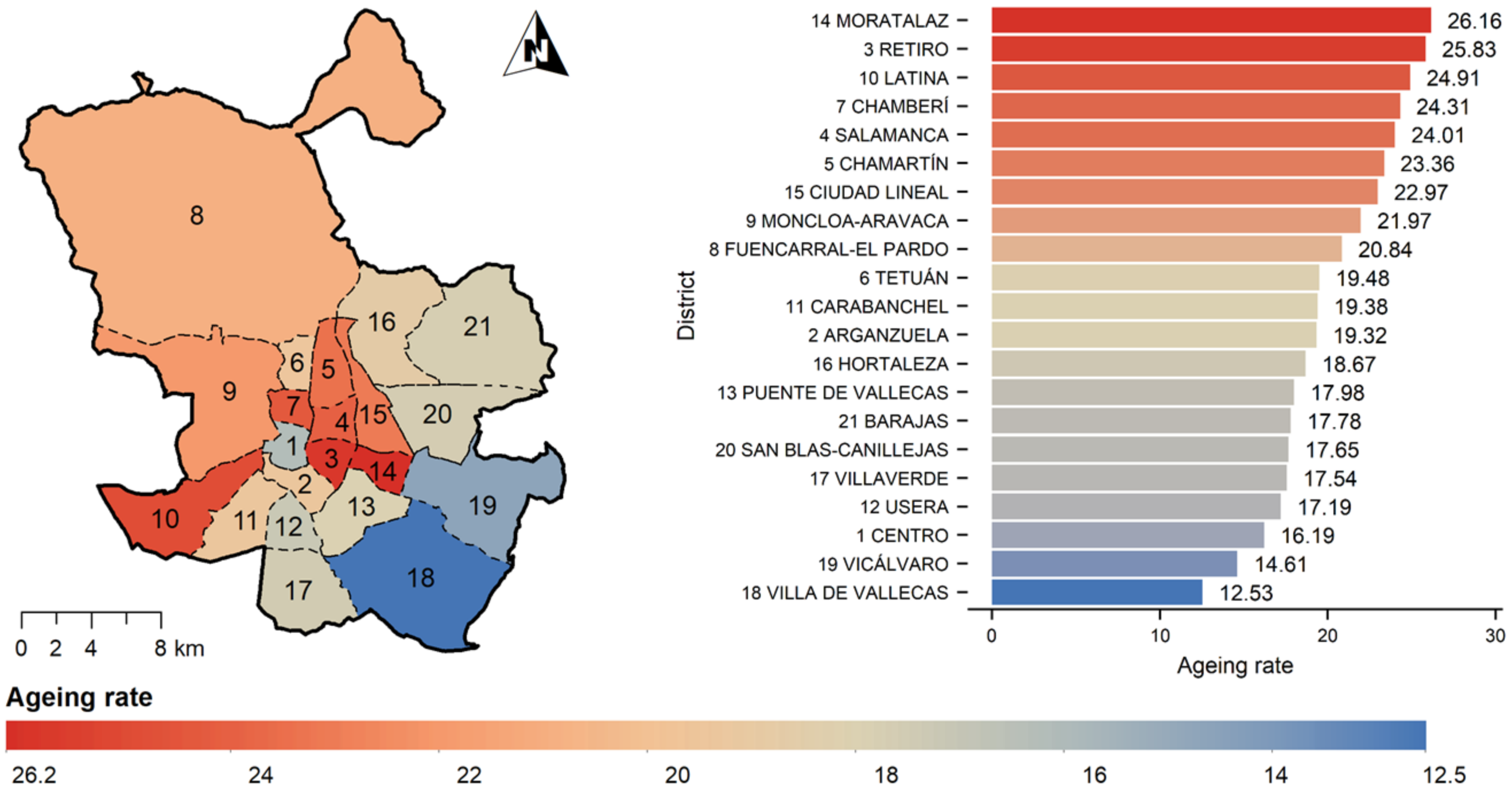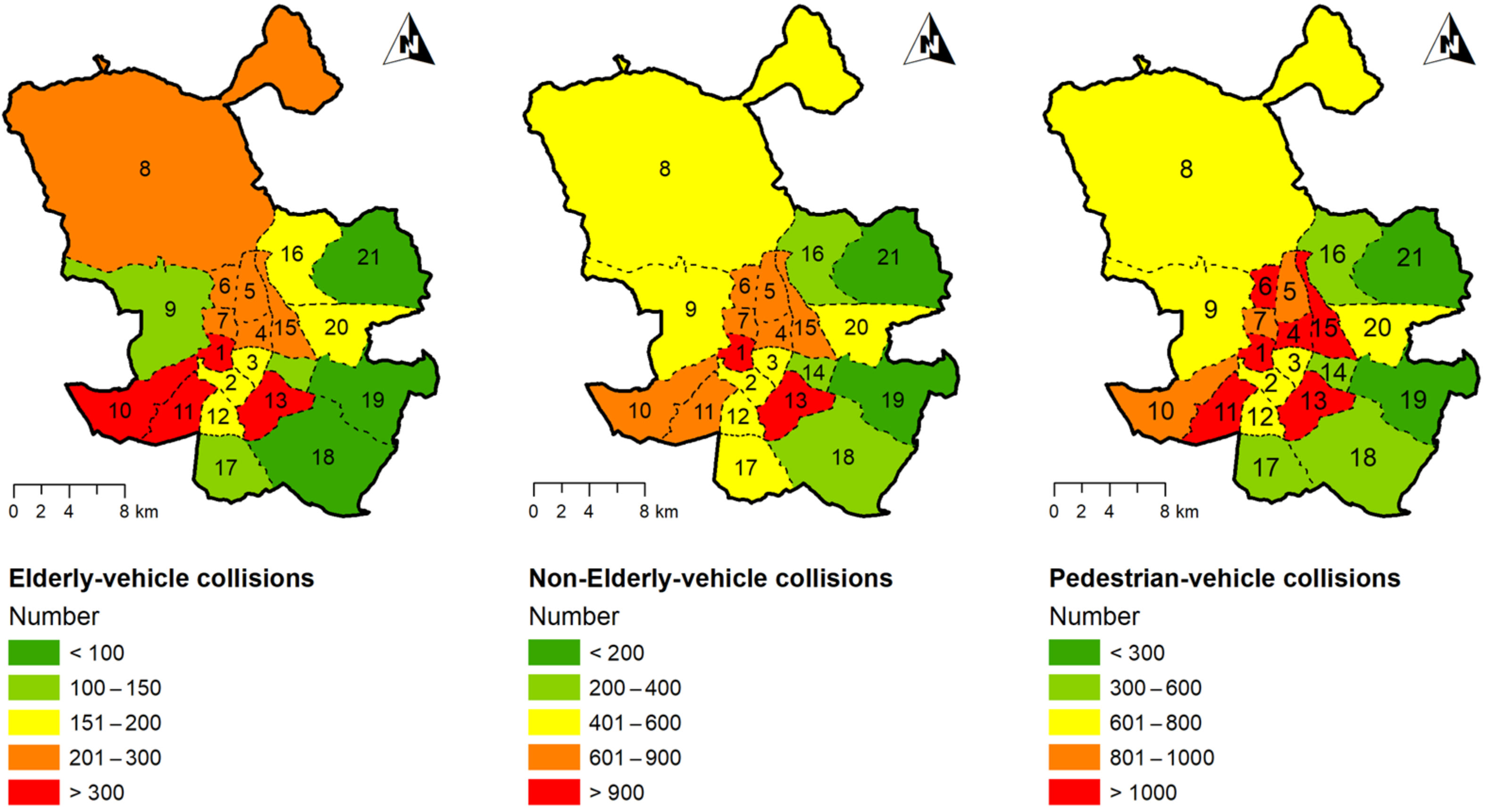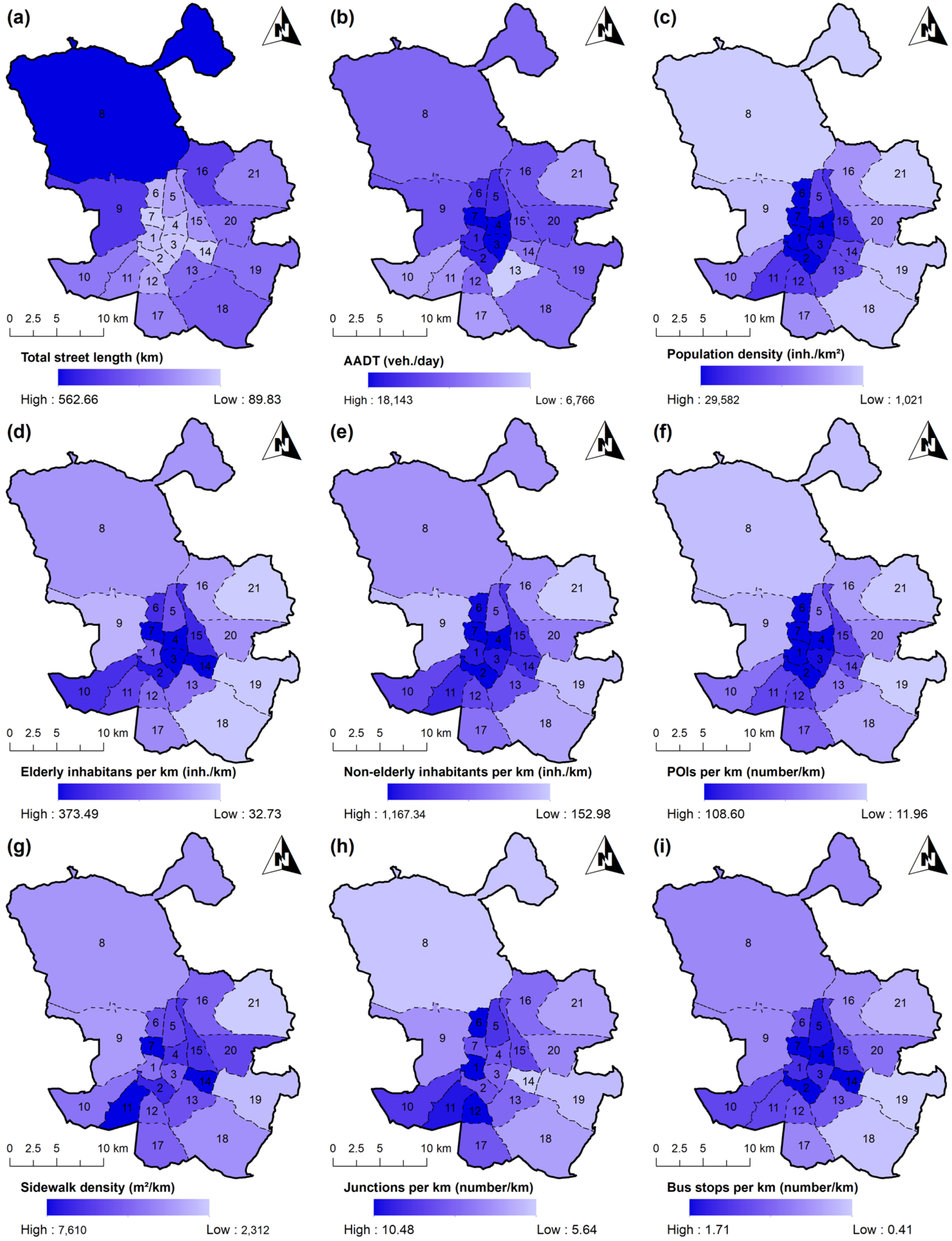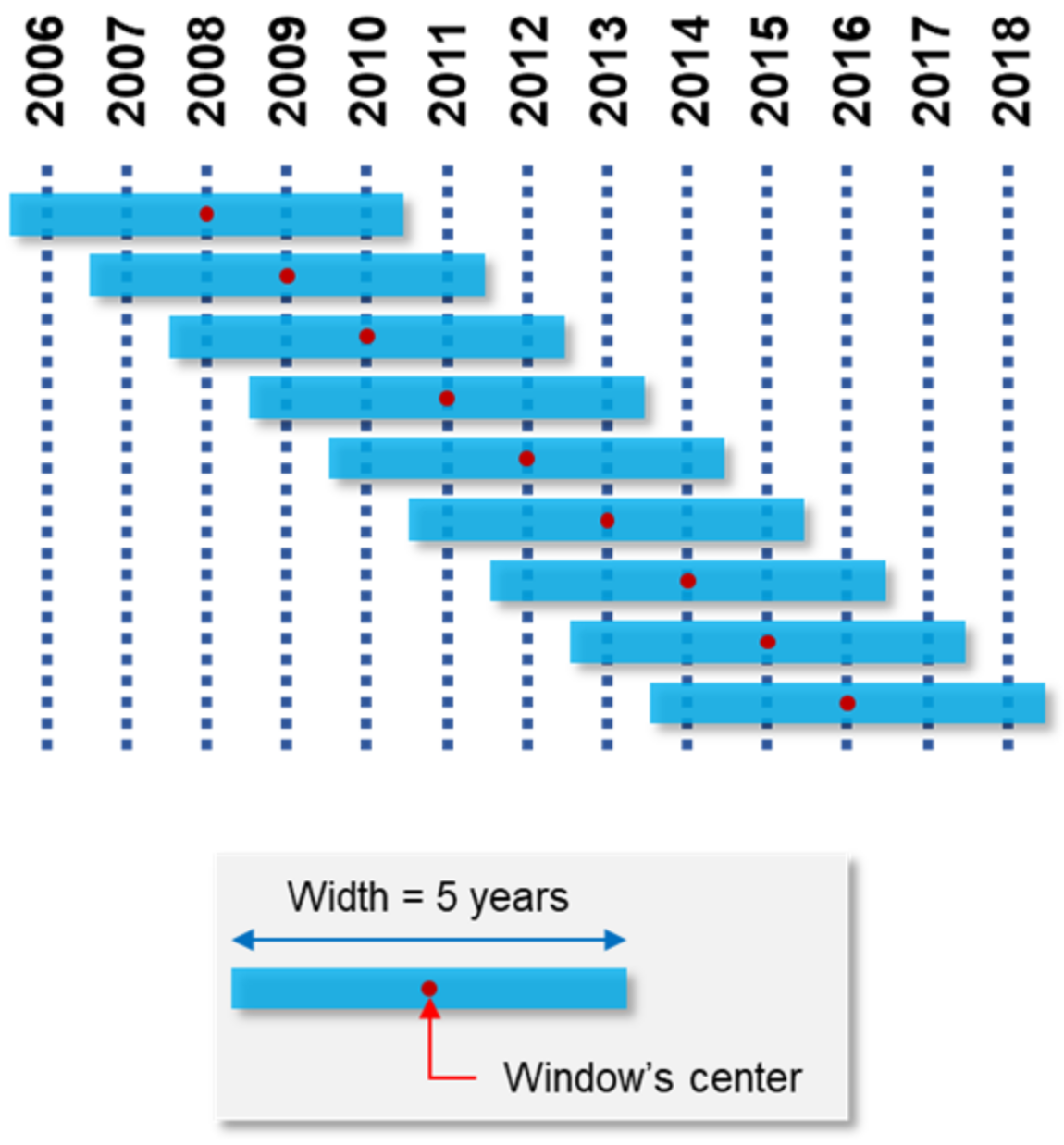The Influence of Built Environment Factors on Elderly Pedestrian Road Safety in Cities: The Experience of Madrid
Abstract
:1. Introduction
2. State of the Art on Road Safety of Pedestrians and Elderly Pedestrians
3. Materials and Methods
3.1. Madrid Case Study
3.2. Methodology
4. Modelling Results
5. Conclusions and Discussion
Author Contributions
Funding
Institutional Review Board Statement
Informed Consent Statement
Data Availability Statement
Acknowledgments
Conflicts of Interest
References
- Population Division—Desa. World Population Prospects—The 2015 Revision: Key Findings and Advance Tables; United Nations: New York, NY, USA, 2015. [Google Scholar]
- Dugan, E.; Lee, C.M. Biopsychosocial Risk Factors for Driving Cessation: Findings from the Health and Retirement Study. J. Aging Health 2013, 25, 1313–1328. [Google Scholar] [CrossRef] [PubMed]
- Musselwhite, C.; Holland, C.; Walker, I. The Role of Transport and Mobility in the Health of Older People. J. Transp. Health 2015, 2, 1–4. [Google Scholar] [CrossRef] [Green Version]
- Nordbakke, S.; Schwanen, T. Well-Being and Mobility: A Theoretical Framework and Literature Review Focusing on Older People. Mobilities 2014, 9, 104–129. [Google Scholar] [CrossRef]
- European Commission. ElderSafe-Risks and Countermeasures for Road Traffic of Elderly in Europe; No. MOVE/C4/2014-244; European Commission-Directorate-General for Mobility and Transport (DG-MOVE): Brussels, Belgium, 2015. [Google Scholar]
- ITF. Pedestrian Safety, Urban Space and Health; OECD Publishing: Paris, France, 2012. [Google Scholar] [CrossRef]
- Dunbar, G.; Holland, C.A.; Maylor, E.A. Older Pedestrians: A Critical Review of the Literature; Department of Transport: London, UK, 2004.
- Oxley, J.; Corben, B.; Fildes, B.; O’Hare, M.; Rothengatter, T. Older Vulnerable Road Users—Measures to Reduce Crash and Injury Risk. Monash Univ. Accid. Res. Cent. Rep. 2004, 218, 162. [Google Scholar]
- Palamara, P.; Broughton, M. An Investigation of Pedestrian Crashes at Traffic Intersections in the Perth Central Business. Regulation 2013, 5, 169–175. [Google Scholar]
- Charlton, J.; Oxley, J.; Koppel, S.; Aburumman, M.; Hua, P.; Williams, T. Older Drivers: A Review of the Literature, Programs and Practices; Monash University: Melbourne, Australia, 2017. [Google Scholar]
- Charlton, J.L.; Oxley, J.; Fildes, B.; Oxley, P.; Newstead, S.; Koppel, S.; O’Hare, M. Characteristics of Older Drivers Who Adopt Self-Regulatory Driving Behaviours. Transp. Res. Part F Traffic Psychol. Behav. 2006, 9, 363–373. [Google Scholar] [CrossRef]
- Langford, J.; Bohensky, M.; Koppel, S.; Newstead, S. Do Older Drivers Pose a Risk to Other Road Users? Traffic Inj. Prev. 2008, 9, 181–189. [Google Scholar] [CrossRef]
- Langford, J.; Methorst, R.; Hakamies-Blomqvist, L. Older Drivers Do Not Have a High Crash Risk—A Replication of Low Mileage Bias. Accid. Anal. Prev. 2006, 38, 574–578. [Google Scholar] [CrossRef]
- Henary, B.Y.; Ivarsson, J.; Crandall, J.R. The Influence of Age on the Morbidity and Mortality of Pedestrian Victims. Traffic Inj. Prev. 2006, 7, 182–190. [Google Scholar] [CrossRef]
- Bernhoft, I.M.; Carstensen, G. Preferences and Behaviour of Pedestrians and Cyclists by Age and Gender. Transp. Res. Part F Traffic Psychol. Behav. 2008, 11, 83–95. [Google Scholar] [CrossRef]
- Clarke, P.; Gallagher, N.A. Optimizing Mobility in Later Life: The Role of the Urban Built Environment for Older Adults Aging in Place. J. Urban Health 2013, 90, 997–1009. [Google Scholar] [CrossRef] [Green Version]
- Phillips, J.; Walford, N.; Hockey, A.; Foreman, N.; Lewis, M. Older People and Outdoor Environments: Pedestrian Anxieties and Barriers in the Use of Familiar and Unfamiliar Spaces. Geoforum 2013, 47, 113–124. [Google Scholar] [CrossRef] [Green Version]
- Corazza, M.V.; Di Mascio, P.; Moretti, L. Management of Sidewalk Maintenance to Improve Walking Comfort for Senior Citizens. WIT Trans. Built Environ. 2017, 176, 195–206. [Google Scholar]
- Ståhl, A.; Carlsson, G.; Hovbrandt, P.; Iwarsson, S. “Let’s Go for a Walk!”: Identification and Prioritisation of Accessibility and Safety Measures Involving Elderly People in a Residential Area. Eur. J. Ageing 2008, 5, 265–273. [Google Scholar] [CrossRef] [Green Version]
- Dirección General de Tráfico (DGT). Las Principales Cifras de La Siniestralidad Vial. España 2019; Dirección General de Tráfico: Madrid, Spain, 2020.
- Gálvez-Pérez, D.; Guirao, B.; Ortuño, A. Road Safety of Elderly Pedestrians in the Urban Context: An Approach Based on Infrastructure and Socioeconomic Variables. Transp. Res. Procedia 2021, 58, 254–261. [Google Scholar] [CrossRef]
- Cervero, R.; Sarmiento, O.L.; Jacoby, E.; Gomez, L.F.; Neiman, A. Influences of Built Environments on Walking and Cycling: Lessons from Bogotá. Int. J. Sustain. Transp. 2009, 3, 203–226. [Google Scholar] [CrossRef]
- Khan, M.; Kockelman, K.M.; Xiong, X. Models for Anticipating Non-Motorized Travel Choices, and the Role of the Built Environment. Transp. Policy 2014, 35, 117–126. [Google Scholar] [CrossRef]
- Orellana, D.; Guerrero, M.L. Exploring the Influence of Road Network Structure on the Spatial Behaviour of Cyclists Using Crowdsourced Data. Environ. Plan. B Urban Anal. City Sci. 2019, 46, 1314–1330. [Google Scholar] [CrossRef]
- Talavera-Garcia, R.; Soria-Lara, J.A. Q-PLOS, Developing an Alternative Walking Index. A Method Based on Urban Design Quality. Cities 2015, 45, 7–17. [Google Scholar]
- Sevtsuk, A.; Basu, R.; Li, X.; Kalvo, R. A Big Data Approach to Understanding Pedestrian Route Choice Preferences: Evidence from San Francisco. Travel Behav. Soc. 2021, 25, 41–51. [Google Scholar] [CrossRef]
- Stoker, P.; Garfinkel-Castro, A.; Khayesi, M.; Odero, W.; Mwangi, M.N.; Peden, M.; Ewing, R. Pedestrian Safety and the Built Environment: A Review of the Risk Factors. J. Plan. Lit. 2015, 30, 377–392. [Google Scholar] [CrossRef]
- Tiwari, G. Progress in Pedestrian Safety Research. Int. J. Inj. Control Saf. Promot. 2020, 27, 35–43. [Google Scholar] [CrossRef]
- Culver, G. Death and the Car: On (Auto) Mobility, Violence, and Injustice. ACME Int. J. Crit. Geogr. 2018, 17, 144–170. [Google Scholar]
- Jackson, S.; Miranda-Moreno, L.F.; St-Aubin, P.; Saunier, N. Flexible, Mobile Video Camera System and Open Source Video Analysis Software for Road Safety and Behavioral Analysis. Transp. Res. Rec. 2013, 2365, 90–98. [Google Scholar] [CrossRef]
- Teknomo, K. Application of Microscopic Pedestrian Simulation Model. Transp. Res. Part F Traffic Psychol. Behav. 2006, 9, 15–27. [Google Scholar] [CrossRef]
- Sandels, S. Young Children in Traffic. Br. J. Educ. Psychol. 1970, 40, 111–116. [Google Scholar] [CrossRef]
- Clifton, K.J.; Burnier, C.V.; Akar, G. Severity of Injury Resulting from Pedestrian–Vehicle Crashes: What Can We Learn from Examining the Built Environment? Transp. Res. Part D Transp. Environ. 2009, 14, 425–436. [Google Scholar] [CrossRef]
- World Health Organization. Global Age-Friendly Cities: A Guide: World Health Organization; World Health Organization: Geneva, Switzerland, 2007. [Google Scholar]
- Demasi, F.; Loprencipe, G.; Moretti, L. Road Safety Analysis of Urban Roads: Case Study of an Italian Municipality. Safety 2018, 4, 58. [Google Scholar] [CrossRef] [Green Version]
- Galanis, A.; Botzoris, G.; Eliou, N. Pedestrian Road Safety in Relation to Urban Road Type and Traffic Flow. Transp. Res. Procedia 2017, 24, 220–227. [Google Scholar] [CrossRef]
- Kim, D. The Transportation Safety of Elderly Pedestrians: Modeling Contributing Factors to Elderly Pedestrian Collisions. Accid. Anal. Prev. 2019, 131, 268–274. [Google Scholar] [CrossRef]
- Lv, M.; Wang, N.; Yao, S.; Wu, J.; Fang, L. Towards Healthy Aging: Influence of the Built Environment on Elderly Pedestrian Safety at the Micro-Level. Int. J. Environ. Res. Public Health 2021, 18, 9534. [Google Scholar] [CrossRef] [PubMed]
- Koepsell, T.; McCloskey, L.; Wolf, M.; Moudon, A.V.; Buchner, D.; Kraus, J.; Patterson, M. Crosswalk Markings and the Risk of Pedestrian–Motor Vehicle Collisions in Older Pedestrians. JAMA 2002, 288, 2136–2143. [Google Scholar] [CrossRef] [PubMed]
- Kubitzki, J.; Janitzek, T. Safety and Mobility of Older Road Users; Allianz Deutschland AG: Munich, Germany, 2009. [Google Scholar]
- Feypell, V.; Methorst, R.; Hughes, T. Non-Motor Pede-Strian Accidents: A Hidden Issue, Results of the ITF/OECD Report on Pedestrian Safety, Urban Space and Health. Available online: https://www.ictct.net/wp-content/uploads/23-Hague-2010/ictct_document_nr_740.pdf (accessed on 1 September 2021).
- Wedagama, D.M.P.; Bird, R.N.; Metcalfe, A.V. The Influence of Urban Land-Use on Non-Motorised Transport Casualties. Accid. Anal. Prev. 2006, 38, 1049–1057. [Google Scholar] [CrossRef] [PubMed]
- Wier, M.; Weintraub, J.; Humphreys, E.H.; Seto, E.; Bhatia, R. An Area-Level Model of Vehicle-Pedestrian Injury Collisions with Implications for Land Use and Transportation Planning. Accid. Anal. Prev. 2009, 41, 137–145. [Google Scholar] [CrossRef]
- Ukkusuri, S.; Miranda-Moreno, L.F.; Ramadurai, G.; Isa-Tavarez, J. The Role of Built Environment on Pedestrian Crash Frequency. Saf. Sci. 2012, 50, 1141–1151. [Google Scholar] [CrossRef]
- Apardian, R.E.; Smirnov, O. An Analysis of Pedestrian Crashes Using a Spatial Count Data Model. Pap. Reg. Sci. 2020, 99, 1317–1338. [Google Scholar] [CrossRef]
- Lee, S.; Yoon, J.; Woo, A. Does Elderly Safety Matter? Associations between Built Environments and Pedestrian Crashes in Seoul, Korea. Accid. Anal. Prev. 2020, 144, 105621. [Google Scholar]
- INE. INEbase/Demography and Population. 2019. Available online: https://www.ine.es/dyngs//INEbase/en/listaoperaciones.htm (accessed on 1 September 2021).
- Schmid, K. World Population Ageing 2019; Department of Economic and Social Affairs Population Division: New York, NY, USA, 2020. [Google Scholar]
- Casado-Sanz, N.; Guirao, B.; Gálvez-Pérez, D. Population Ageing and Rural Road Accidents: Analysis of Accident Severity in Traffic Crashes with Older Pedestrians on Spanish Crosstown Roads. Res. Transp. Bus. Manag. 2019, 30, 100377. [Google Scholar] [CrossRef]
- Casado-Sanz, N.; Guirao, B.; Lara Galera, A.; Attard, M. Investigating the Risk Factors Associated with the Severity of the Pedestrians Injured on Spanish Crosstown Roads. Sustainability 2019, 11, 5194. [Google Scholar] [CrossRef] [Green Version]
- Ayuntamiento de Madrid. Plan General de Ordenación Urbana de Madrid. PGOUM-97; Ayuntamiento de Madrid: Madrid, Spain, 1997.
- Ziakopoulos, A.; Yannis, G. A Review of Spatial Approaches in Road Safety. Accid. Anal. Prev. 2020, 135, 105323. [Google Scholar] [CrossRef]
- Hilbe, J.M. Negative Binomial Regression; Cambridge University Press: Cambridge, UK, 2011; ISBN 0521198151. [Google Scholar]
- Mozaffari, L.; Mozaffari, A.; Azad, N.L. Vehicle Speed Prediction via a Sliding-Window Time Series Analysis and an Evolutionary Least Learning Machine: A Case Study on San Francisco Urban Roads. Eng. Sci. Technol. Int. J. 2015, 18, 150–162. [Google Scholar] [CrossRef] [Green Version]
- Fitzpatrick, K.; Avelar, R.E.; Turner, S.M. Identification of High Pedestrian Crash Locations; Technical Report HWA-HRT-17-108; U.S. Department of Transportation, Federal Highway Administration: McLean, VA, USA, 2018.




| Variable | Unit | Min. | Max. | Mean | Median | σ (SD) |
|---|---|---|---|---|---|---|
| Exposure | ||||||
| Total street length (L) | km | 89.83 | 562.66 | 243.54 | 252.82 | 123.28 |
| AADT (AADT) | veh./day | 6766.00 | 18,143.00 | 11,299.00 | 11,052.00 | 2727.46 |
| Socioeconomics | ||||||
| Elderly inhabitants per km (InhExp) | inh./km | 18.80 | 378.02 | 157.24 | 157.22 | 92.35 |
| Non-elderly inhabitants per km (InhExp) | inh./km | 148.00 | 1298.70 | 622.70 | 642.00 | 298.14 |
| Population density (Pop D) | inh./km2 | 880.00 | 32,227.00 | 14,263.00 | 15,822.00 | 9726.10 |
| Average income per household (AI) | €/district | 23,517.00 | 70,735.00 | 38,456.00 | 35,532.00 | 10,992.18 |
| Land use | ||||||
| POIs per km (POIs) | points/km | 11.96 | 108.60 | 49.14 | 43.09 | 28.17 |
| Residential proportion (R Prop) | % Surface | 0.03 | 0.48 | 0.27 | 0.28 | 0.14 |
| Green area proportion (G Prop) | % Surface | 0.00 | 0.41 | 0.08 | 0.05 | 0.09 |
| Main street proportion (MS Prop) | % Surface | 0.28 | 0.68 | 0.46 | 0.46 | 0.10 |
| Infrastructure | ||||||
| Sidewalk density (Swk D) | m2/km | 2312.00 | 7610.00 | 4702.00 | 4588.00 | 1370.84 |
| Junctions per km (Junct) | junctions/km | 5.64 | 10.48 | 7.59 | 7.68 | 1.27 |
| Signals per km (Signals) | signals/km | 14.47 | 83.05 | 42.95 | 40.41 | 16.35 |
| Traffic lights per km (TLights) | lights/km | 1.62 | 21.02 | 9.16 | 8.10 | 4.83 |
| Metro stations per km (Metro) | stations/km | 0.00 | 0.36 | 0.08 | 0.04 | 0.09 |
| Bus stops per km (Bus) | stops/km | 0.26 | 1.71 | 1.01 | 1.05 | 0.39 |
| Model 1: Elderly Pedestrians | Model 1 and Model 2 Comparison | Model 2: Other Pedestrians | ||||||||
|---|---|---|---|---|---|---|---|---|---|---|
| Variable | Estimate | S. Error | z Value | Sign | p-Value | Estimate | S. Error | z Value | ||
| Intercept | −1.49 × 10−1 | 1.21 | −12.321 | *** | = | < | −8.15 | 9.50 × 10−1 | −8.574 | *** |
| Exposure | ||||||||||
| log (Total street length) | 2.00 | 1.10 × 10−1 | 18.199 | *** | = | < | 1.55 | 9.92 × 10−2 | 15.659 | *** |
| log (AADT) | 5.73 × 10−1 | 1.14 × 10−1 | 5.032 | *** | = | < | 1.26 × 10−1 | 8.08 × 10−2 | 1.563 | |
| Socioeconomics | ||||||||||
| Inhabitants per km | 2.74 × 10−3 | 3.20 × 10−4 | 8.572 | *** | = | < | 5.80 × 10−5 | 2.01 × 10−4 | 0.289 | |
| Population density | 6.01 × 10−5 | 7.48 × 10−6 | 8.036 | *** | = | > | 8.33 × 10−5 | 7.07 × 10−6 | 11.787 | *** |
| Average income | −2.42 × 10−5 | 2.50 × 10−6 | −9.661 | *** | = | < | −1.66 × 10−5 | 1.92 × 10−6 | −8.624 | *** |
| Land use | ||||||||||
| POIs per km | 2.42 × 10−3 | 3.49 × 10−3 | 0.693 | ≠ | > | −1.20 × 10−2 | 3.42 × 10−3 | −3.500 | *** | |
| Residential proportion | 9.26 × 10−1 | 5.43 × 10−1 | 1.705 | . | ≠ | > | −1.66 | 4.47 × 10−1 | −3.705 | *** |
| Green area proportion | 5.98 × 10−2 | 1.54 × 10−1 | 0.388 | = | > | 8.20 × 10−1 | 1.44 × 10−1 | 5.691 | *** | |
| Main street proportion | 2.04 | 4.59 × 10−1 | 4.436 | *** | = | > | 2.04 | 3.58 × 10−1 | 5.692 | *** |
| Infrastructure | ||||||||||
| Sidewalk density | −8.26 × 10−5 | 1.57 × 10−5 | −5.276 | *** | = | < | −1.39 × 10−5 | 1.38 × 10−5 | −1.010 | |
| Junctions per km | 8.15 × 10−2 | 2.65 × 10−2 | 3.078 | ** | = | > | 2.18 × 10−1 | 2.40 × 10−2 | 9.078 | *** |
| Signals per km | −1.42 × 10−3 | 2.92 × 10−3 | −0.488 | ≠ | > | 1.17 × 10−2 | 2.67 × 10−3 | 4.389 | *** | |
| Traffic lights per km | −2.50 × 10−2 | 8.66 × 10−3 | −2.889 | ** | ≠ | < | 7.73 × 10−3 | 8.68 × 10−3 | 0.891 | |
| Metro stations per km | 3.87 × 10−1 | 4.20 × 10−1 | 0.920 | = | > | 2.65 | 3.55 × 10−1 | 7.465 | *** | |
| Bus stops per km | 1.42 | 1.20 × 10−1 | 11.820 | *** | = | < | 9.41 × 10−1 | 1.28 × 10−1 | 7.367 | *** |
| Number of observations (n) | 189 | 189 | ||||||||
| AIC | 1444.2 | 1713.6 | ||||||||
| Log-likelihood | −705.1 | −839.8 | ||||||||
Publisher’s Note: MDPI stays neutral with regard to jurisdictional claims in published maps and institutional affiliations. |
© 2022 by the authors. Licensee MDPI, Basel, Switzerland. This article is an open access article distributed under the terms and conditions of the Creative Commons Attribution (CC BY) license (https://creativecommons.org/licenses/by/4.0/).
Share and Cite
Gálvez-Pérez, D.; Guirao, B.; Ortuño, A.; Picado-Santos, L. The Influence of Built Environment Factors on Elderly Pedestrian Road Safety in Cities: The Experience of Madrid. Int. J. Environ. Res. Public Health 2022, 19, 2280. https://doi.org/10.3390/ijerph19042280
Gálvez-Pérez D, Guirao B, Ortuño A, Picado-Santos L. The Influence of Built Environment Factors on Elderly Pedestrian Road Safety in Cities: The Experience of Madrid. International Journal of Environmental Research and Public Health. 2022; 19(4):2280. https://doi.org/10.3390/ijerph19042280
Chicago/Turabian StyleGálvez-Pérez, Daniel, Begoña Guirao, Armando Ortuño, and Luis Picado-Santos. 2022. "The Influence of Built Environment Factors on Elderly Pedestrian Road Safety in Cities: The Experience of Madrid" International Journal of Environmental Research and Public Health 19, no. 4: 2280. https://doi.org/10.3390/ijerph19042280
APA StyleGálvez-Pérez, D., Guirao, B., Ortuño, A., & Picado-Santos, L. (2022). The Influence of Built Environment Factors on Elderly Pedestrian Road Safety in Cities: The Experience of Madrid. International Journal of Environmental Research and Public Health, 19(4), 2280. https://doi.org/10.3390/ijerph19042280








